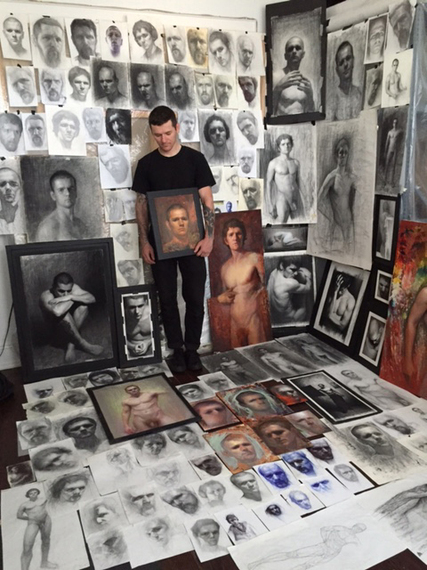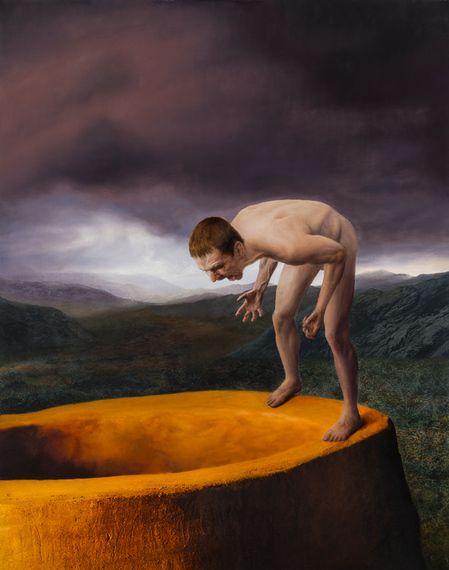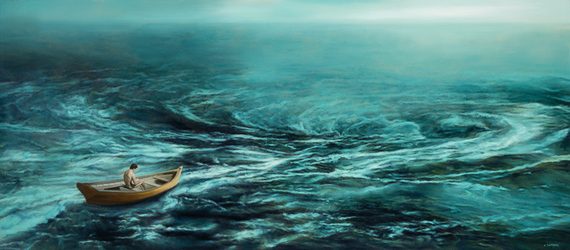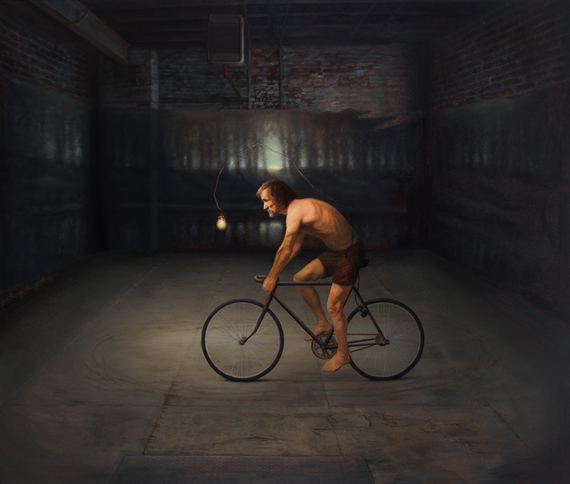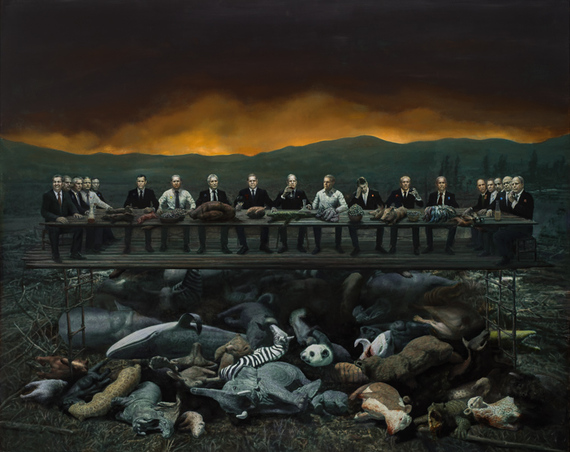We were both working on Unbreakable Kimmy Schmidt when I first met William Thompson. By our 9:00am break that same day I learned just how dedicated he was to his art. Today, as we both work on the second season of the hit comedy-drama Master of None, I see more than ever his unrelenting devotion to art.
As a scenic artist and a member of Local 829 you are afforded scheduled breaks at various times of the work day, which most often is ten hours long. During these breaks, and for the large majority of scenic artists, you will hear lively conversation and observe smart phone surfing and snacking. This is not the case with Thompson. He will most often be sitting somewhere, alone and drawing in a small, softbound sketchbook he keeps in his pocket. This is not to say he is anti-social. The reality is quite the contrary - Thompson is funny, intelligent, an excellent scenic and a joy to work with. However, what is most important to know about Thompson is that he is a talented and passionate artist who makes powerful images that are as introspective and haunting as they are visceral and emotive. His art ranges vastly in size and in scope depending on the content of each work. Most of the time he presents himself as the subject, whether he is the protagonist, the victim or just an innocent witness. In many ways, his art parallels contemporary society as he uses quite beautifully, metaphor and symbolism to make his notions, feeling and observations known. Yet there is always mystery, something we cannot know about him that keeps us as viewers quizzically intrigued.
The following is a conversation I had with Thompson where I've given him a chance to unravel his passions, uncomfortable realities, and struggles he has put forth in his work.
DDL: First, I want to mention that you will have a self-portrait in Facie: Self-Portraiture Interpreted by 25 Artists, which is a show I curated for Galerie Protégé in New York City. The painting I selected is quite small, but incredibly powerful as your use of red to enhance the form goes beyond reality and into a psychosocial realm. Can you tell me a bit about your thinking behind this work, as well as your self-portraiture in general?
WT: Before we begin, I'd like to thank you for that very kind intro, it is very much appreciated. I am looking forward to and honored to be a part of the upcoming Facie show, which promises to be a very exciting collection of work. My piece in the show, Self-Portrait Red (2012), is one where I use color 'temperature' to describe an internal emotional struggle. The juxtaposition of the intense warmth of the red, combined with the almost cold grey describes my attempt to balance a strong sense of peace and calm with that of severe anger and turmoil. This is an emotional state that I seem to permanently find myself in, and it is a common theme in most of my work.
The self-portrait has always been a sort of daily meditation for me. It is a very grounding way to keep my skills up for some of the larger, more ambitious paintings. Over time, they have become a visual diary of my life, the experiences I've lived through and a very clear indicator of the way that I've aged over time (I try to be honest in my execution). The subtle expression or gaze I capture in these works is a reminder of what was going on in my life at that particular time. As you might can see in the image of my self-portrait installation, the consistent quantity of self-portraits that I produce gives one a glimpse into my attempt to control/calm my obsessive compulsive tendencies, and use them for something that is productive and creative. The self-portrait is something that is eternally infused in my work. I believe that by expressing my own experiences in a very honest and straightforward way will hopefully touch upon something familiar and relatable to the world outside.
DDL: I have to say, I am deeply impressed by the vast number and quality of the self-portraits, while hearing how they all have a function beyond their visual impressiveness that makes them even more powerful. I'm reminded of the self-portraits of Vincent van Gogh and Frida Kahlo and the portraits of Alice Neel when I hear you talk about your self-portraits as all three used the this genre less as a record of a physical appearance and more of a very revealing recording of a mental state.
Tell me about The Well (2014). The stormy sky and the futility of yelling into the abyss, the endless uninhabited landscape and the color of the well are all simultaneously primal and perplexing.
WT: The Well was conceived out of the idea of trying to guard and safely contain certain feelings/emotions that are very sensitive, intimate and sacred to me. I've always had a very difficult time expressing myself verbally, which is exacerbated by a very strong social phobia (which I've tried to manage since a young age). It's just always been easier to express myself through visual means. I feel as though it is my responsibility to honor a feeling/thought by communicating it in a creative manner. So The Well represents what painting is for me, a reliquary for storing my most intimate feelings/thoughts - it is the facilitator that allows me to honor these emotions by expressing them in the most respectful and clearest way that I know how.
The desolate and barren landscape serves to further reinforce the privacy and intimacy of The Well. It serves to give greater emphasis to the isolation and solitude that I associate with painting. The intensity of the figure's scream and the notion that at any moment he may leap into the well expresses how all consuming this manner of communication is for me.
DDL: There is, with The Well and many other paintings, a sense of frustration and release in your work. I find it most interesting how focused and defined you are in the way you indicate your visions and feelings. Every little detail counts, a full, all in approach to your message - nothing is overlooked. In that way, your art immediately becomes classic, even timeless as these feelings you express are primal and as old as mankind. I also believe that your traits are part of the artistic mentality that is both a blessing and a curse. We've both heard many times how someone from the outside might be thinking "ah, the life of the artist, doing what you want, having fun painting and drawing..." but it's really not like that at all. It takes a tremendous amount of hard work and dedication to create something that is living in your mind and something has to fuel that and it is very often a negative observation or a bad feeling that you are trying to erase or shed light on and it's all very personal. The struggling artist model is not about the money; it's about the emotional side, and more specifically in your case, the social phobia that only makes the whole situation more driven by pain.
I'm not aware of any of your influences but the Norwegian artist Odd Nerdrum comes to mind as he too reveals much more pain and anxiety in his work than one is used to seeing.
Maelstrom (2014) looks to me to be about total submission. Here, we see you in a small wooden boat, oar-less and heading for a relentless whirlpool that is about to swallow you and your boat whole. The sea, which is icy cold with puffs of fog hovering just above the surface, is patiently waiting to cool your soul to its very core.
WT: That was very beautifully stated, and perfectly describes what I've always known painting to be about. Yes, I think that using painting for catharsis is extraordinarily fulfilling and satisfying, but it's also very excruciating and emotionally draining most of the time. To spend each day (for months) reliving and working through deeply wounding emotions (in painstaking detail) is a very strange way to work through them - there's certainly nothing "carefree" about it. But at the end of that long process, with the finished piece, you do gain some sort of reconciliation, and you have produced something that others may relate to or gain some sort of comfort from. It's a time consuming but very gratifying way to communicate extremely private emotions and hopefully make a meaningful and sincere connection with the viewer.
I do like Nerdrum, although I haven't really followed him in quite a while, he was an important early influence. Other influences have included: Jusepe de Ribera, Käthe Kollwitz, Rembrandt, Edward Steichen, Antonio Ciseri, Ivan Kramskoi, Ilya Repin, Jacek Malczewski, Franz Kline were also early influences. At some point though, I stopped looking religiously at these artists, the goal being to internalize and channel them subconsciously rather than directly. I believe it's also necessary to leave early influences behind if you have any chance of finding your own voice. Nowadays I draw a lot of inspiration from the music that I listen to. Bands that most accurately match the mood and energy that I want to convey with the painting.
Maelstrom is very much about total submission. I've always been fascinated by the idea of a maelstrom. The almost mythic status of a giant vortex in the middle of the sea, being swept up by such a powerful natural force and following it down to see where it ends. Maelstrom is about completely giving yourself over to what you are passionate about, letting it consume and sweep you away to an uncertain end (the figure here seams very willing to allow himself to be pulled down to an almost certain death). This absolutely parallels the connection that I have with my work, how completely immersive and consuming it can be, and how (at one point or another) it has caused problems with nearly all other areas of life (particularly relationships). There is a second panel to this piece, entitled Maelstrom II, which depicts the aftermath (a figure floats lifelessly underwater, seemingly at peace, but uncertain if still alive).
DDL: We recently talked a little bit about your painting False Hope (2015), how it is not you but something of a metaphor for your older self. This is a man you know of, who always rides a bike like you everywhere he goes throughout the city and beyond. But beyond that, there are a few strong triggers that elicit various narratives. There are two main indicators of futility: the fact the he is cycling in a room with no visible way out; plus the dangling carrot, the light that is just beyond his face but not far enough away to truly enlighten him about his situation. Add to this the subtle circular tire marks on the floor and the hint of the beyond, a translucent, panoramic view of wooded area along a waterway or lake, imagery intended to calm the nerves perhaps? I also find the industrial grade gas heat blower near the ceiling to be a very curious detail. It is like you know this specific place and this exact circumstance even if it is metaphorical in all of its states.
WT: Your reading of this piece is very accurate. False Hope is mainly about experiencing love that is one sided, and the heartbreak involved in pursuing something that will never be reached. A small generator (powering the overhanging light, that is just out of reach) is attached to the bike's wheel, so as long as the bike is pedaled it will keep the light of hope illuminated and the figure will continue to follow it. That blinding desire to obtain the light and embrace something that seems so very close distracts the figure from realizing that he is actually in a cell, riding in circles (going nowhere), futilely chasing something that will never be reached.
Most all of my paintings are metaphors for actual experiences I've had. With False Hope, I was attempting to document my own experience with this sort of relationship, when I actually cycled from NYC all the way to Baltimore to be with someone who I had long been in love with. Over time, I began to realize that the feeling was not mutual and, much like the figure in the painting, I had fooled myself into believing that I would finally reach the light (love). This piece has a specific meaning for me personally, but it can easily be applied to any situation where you pursue something that will never be obtained, which you alone are in control of either stopping or perpetuating.
Yes, the model that I used for this piece is a really interesting individual. He lives in a trailer, in an unkempt lot in Greenpoint (Brooklyn), with 3 mangy looking dogs. He doesn't necessarily have all of his mental facilities, but I always found him so inspiring because no matter where he went, he would either cycle or run as a practical means for doing errands but also as a sort of a compulsive fitness routine. He always wore a very haggard, exhausted expression during his runs that I found to be very familiar, which I also deeply identified with. So, using him as a model was intended to be both a portrayal of my older self and an interpretation of the exact feelings attached to the experience in False Hope.
DDL: I would like to end our conversation discussing what I think is a very significant work for our time, Burning Too (2016). Everything about this painting is alarming and sad. The destruction of the earth's wildlife for personal gain, cronyism, the Last Supper-like staging as a metaphor for one final celebration of 'achievement' before the planet dies as a result of the efforts of big business and the unethical tactics to gain more and more political power. It's all there, greedy men with ice in their veins - who could just sit there and do nothing and believe that they are behaving morally? Unfortunately, it is a sad truth. If we continue to move in our current direction any number of factors could end it all. Burning Too puts forth so much truth that it is hard to take it all in at one time and I admire you greatly for having the strength and the ability to create it.
WT: Again, another very accurate interpretation. With Burning Too, I tried to imagine what the individuals who are the most responsible for our current climate crises would actually behave like during the apocalypse. I imagine that, being the opportunists that they are (benefiting from the worlds greatest tragedies), they would gather up all of the newly extinct species of the world and have one final, decadent feast (presumably to celebrate their greatest and final victory over our planet?). We can see this mentality put into practice even now, where oil companies are able to navigate through new waterways in the arctic (which are now opening up due to the melting glaciers) and exploiting new, untapped reserves that were never possible to reach before. To me, it's baffling and an endless source frustration. It is astounding how the greed and sociopathic practices of just a few powerful industries can potentially decimate all life on this planet, and they seem to be sprinting toward that end.
I also think it's an extremely disheartening fact that we have a significantly large portion of the population who are skeptical of, or flat out reject, the science surrounding climate change. It's made even worse when we have a major party candidate who denies it completely, and proudly runs on that platform. That's a very frightening notion. My hope is that there are enough intelligent people who live in reality and care enough about this issue to make choices that will hopefully lead us away from a future that resembles Burning Too.
DDL: We all need to do what we can to stem the tide. I only hope there is still enough time to do so.

